The 5.56mm and 7.62mm are one of the most used and widely accepted calibers of modern armies. Also known as the .223 and .308 caliber in America, these bullets dominate today’s battlefield. Interestingly, the 5.56mm was designed to replace the 7.62mm starting somewhere in the 1960s, which it was pretty much successful at. However, the 7.62mm still has many pros which prevent it from being phased out.
It will be really interesting to compare these two leaders of the cartridge world and understand the areas of excellence and drawbacks for each. To keep things standardized, we will specifically talk about the 5.56x45mm NATO and 7.62x51mm NATO rounds.
TL;DR: 5.56 vs 7.62mm

5.56mm Ammo
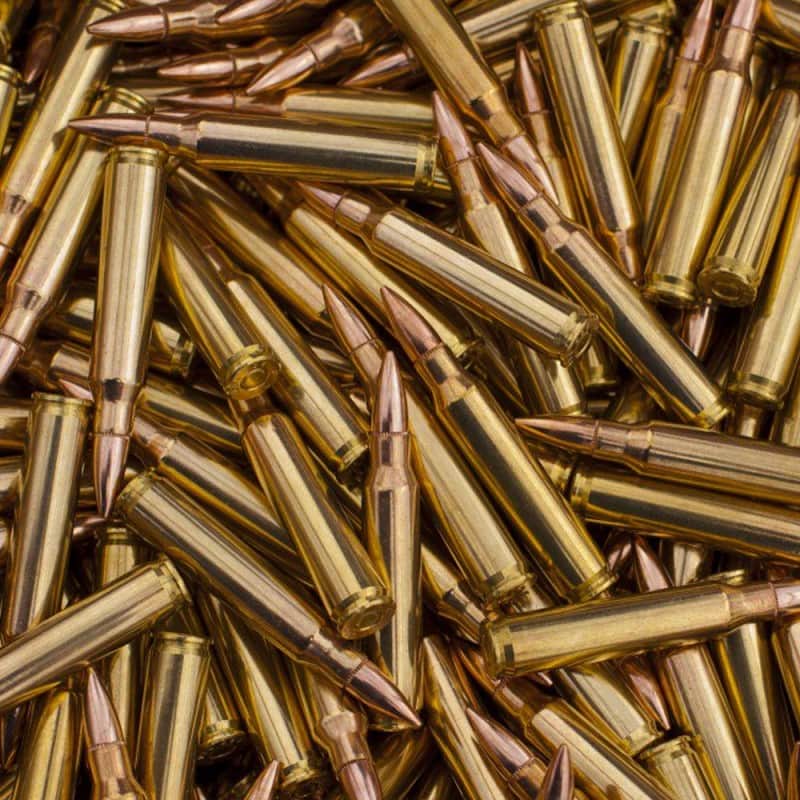
7.62mm Ammo
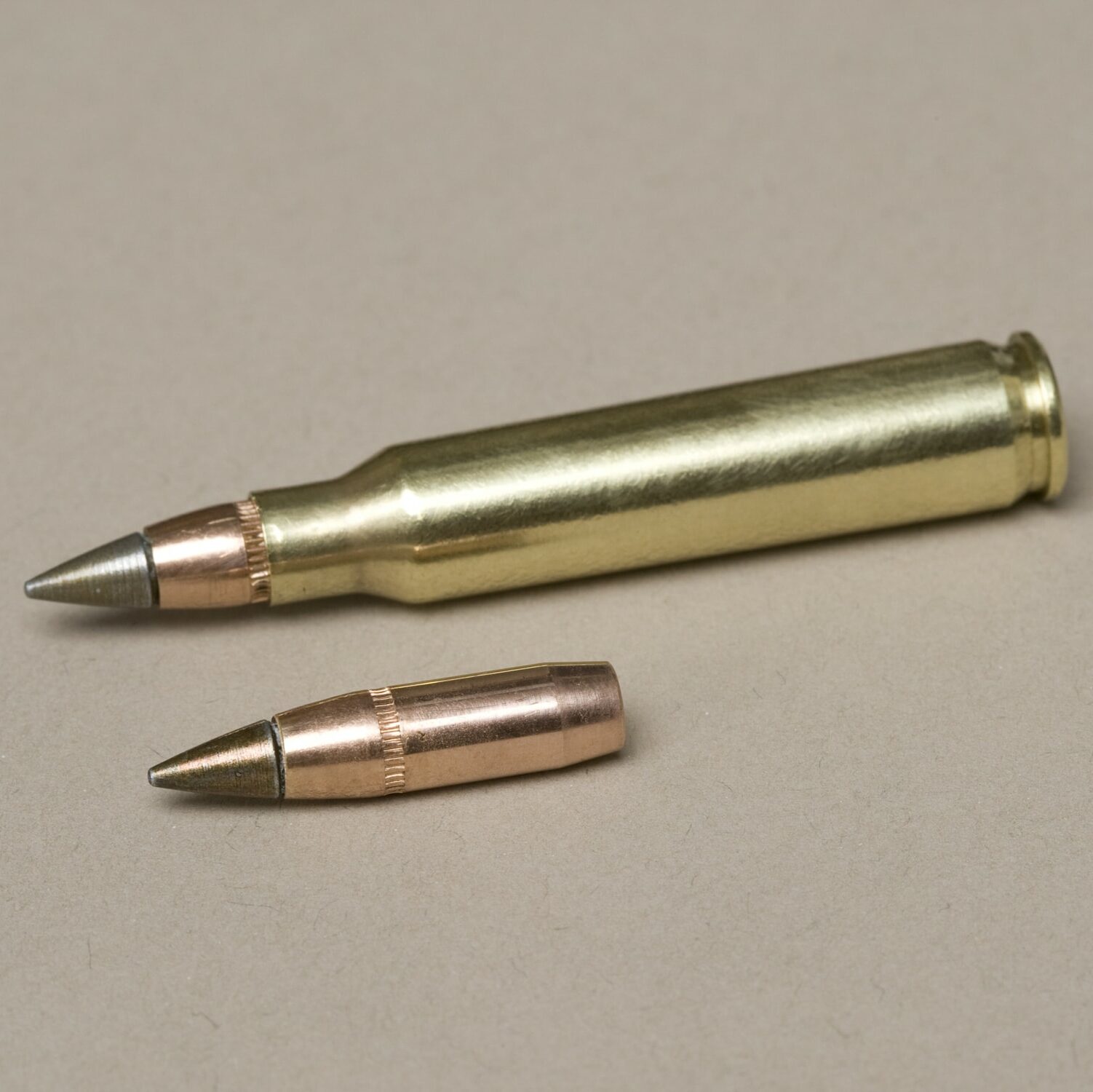
Pros
5.56
Ubiquitously available and used
Lightweight ammo and fast velocity
Lots of ammo variety and available data
Very flat trajectory and can reach long distances
Low recoil and easy to control in semi/full auto
7.62
Long range round with hard-hitting power
Suitable to engage game animals of any size
Easily available and good for precision shooting
Wide range of bullet options and very easy/feasible to reload
Cons
5.56
Wears out the barrel pretty fast
Low stopping power. Especially at long distances
Underpowered and mostly illegal for hunting medium game (deer)
7.62
Short barrel life
Overkill for short range small game
Comparatively more recoil and heavy rifles
Best For
5.56
Great for short or medium range use for plinking, varminting, and even defense. Amazing choice for SHTF.
7.62
Ideal for a mixed medium and long range use with hard-hitting power. Versatile hunting/competition round.
5.56 Overview
The 5.56×45 mm or 5.56 NATO is a rimless bottlenecked intermediate rifle cartridge designed by FN Herstal of Belgium in the 1970s. It uses a .223 Remington parent case and fires a 0.224 inches diameter bullet. However, it is also important to note that the 5.56×45 mm NATO is a more pressurized version of the .223 Remington cartridge.
The .223 Rem was already being used by the U.S forces in the 1960s as a lightweight and lesser recoil replacement to the .30 caliber standard-issue cartridges. The 5.56 NATO operates on higher pressure than the .223 Rem for increased velocity and range. Additionally, it was also seen as a viable option to replace the 7.62×51 mm NATO cartridges.
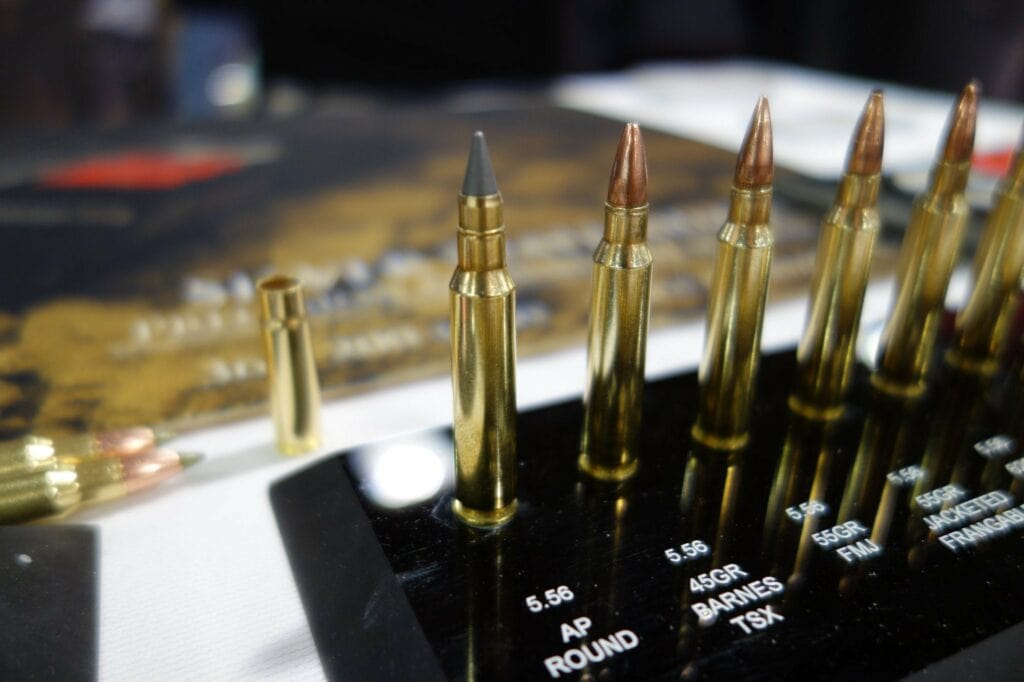
The 5.56 NATO (62-grain bullet) is a lethal round out to 273 yards according to studies concluded by the U.S Military. However, it has an effective range of about 600 yards and retains enough velocity to be used for 1,000-yard targets with a good rifle in the right hands. The standard twist rate for 5.56 NATO chambered rifles is 1:7. A barrel length of 16 inches is considered ideal for this ammo, however, a wide range of options are available out there.
The 5.56 NATO is the officially adopted cartridge of NATO (North Atlantic Treaty Organization), so it is used by 30 countries as their main military cartridge. The famous AR-15 rifle is also chambered for .223 or 5.56 NATO and is the most popular rifle platform in North America.
This round gained popularity as a low recoil and lightweight option which allows soldiers to carry more ammunition at a time. Additionally, the ammo is easy to work with and train new recruits.
7.62 Overview
The 7.62 mm caliber is a very grand collection of bullets in itself. It has been around for a long time now and is as old as the modern cartridge design. The 7.62 mm caliber, also known as the .30 caliber in the imperial measurement system, is the most widely accepted and used caliber in the history of military firearms.
Some popular derivative cartridges of the .30 caliber include 7.62×51 mm NATO, 7.62×39 mm (AK-47 round), 7.62×63 mm (.30-06 Springfield), and the 7.62x54mm (Mosin-Nagant ammo). But we will be talking specifically about the 7.62×51 NATO. Infact, the 7.62 mm caliber has been an inspiration for many successful cartridges and is also seen as a standard for further development.
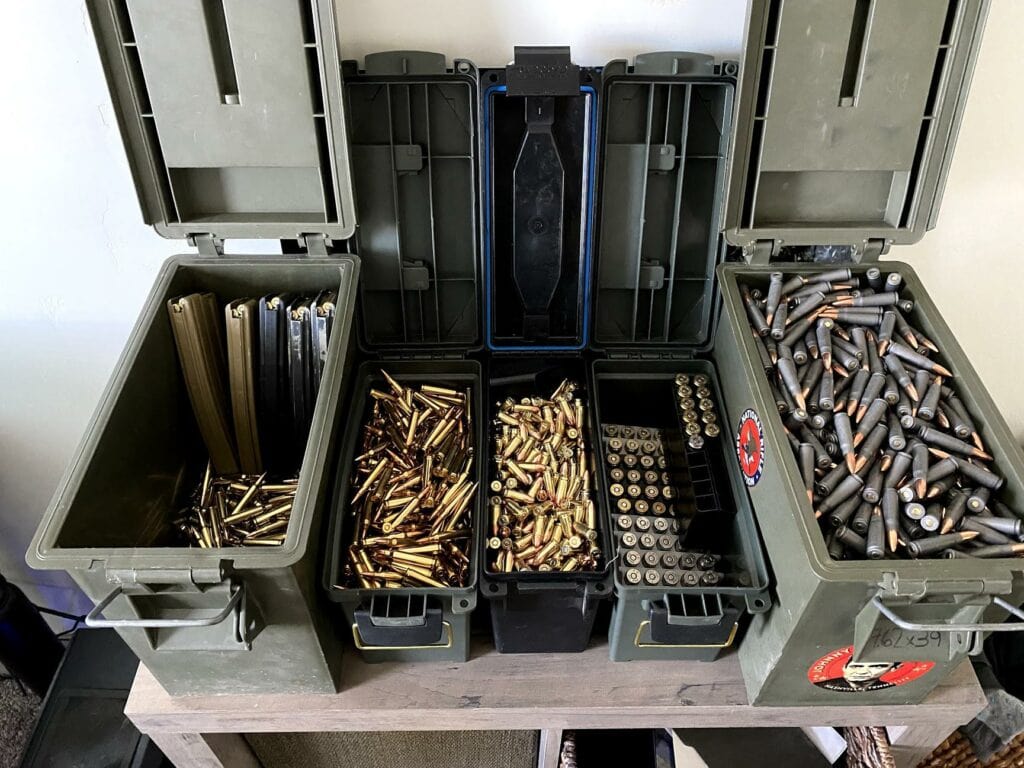
The 7.62×51 mm is a rimless bottlenecked rifle cartridge designed to suit short and long action rifles. It was developed in the early 1950s and adopted by the NATO forces as their standard cartridge in 1954. It uses a .308 inch diameter bullet and has a maximum effective range of 4,000 yards.
However, as far as realistic and common applications are concerned, this is a deadly cartridge out to 800 or 900 yards, and that is what the U.S Army preaches. The most common bullet weights for this cartridge are 147 and 175 grains and it is a very popular choice for long range sniping and light machine guns.
5.56 vs 7.62: Cartridge Specs
Let us closely compare the external and internal dimensions of these two cartridges to get a quick overview of their design.
| 5.56 Specs | 7.62 Specs | |
|---|---|---|
| Bullet Diameter | 0.224 in (5.70 mm) | 0.308 in (7.82 mm) |
| Neck Diameter | 0.253 in (6.43 mm) | 0.345 in (8.8 mm) |
| Base Diameter | 0.377 in (9.58 mm) | 0.470 in (11.9 mm) |
| Case Length | 1.760 in (44.70 mm) | 2.015 in (51.2 mm) |
| Overall Length | 2.260 in (57.40 mm) | 2.800 in (71.1 mm) |
| Case Capacity | 28.5 grains | 52 grains |
| Max Pressure (SAAMI) | 62,366 psi | 60,191 psi |
| Typical Casing Material | Brass | Brass |
| Typical Bullet Weight (gr) | 40-77 grains | 140-175 grains |
The 7.62 mm is clearly a bigger and heavier bullet and case compared to the 5.56 mm. This eventually means that the 7.62 mm cartridge will have more powder, longer case length, and a better effective killing range.
The 7.62 mm is often considered a long action cartridge because of the long 2.8 inches case which is just on the borderline of classification between long and short cases. Due to its long design, the 7.62 NATO rounds will deliver a slower rate of fire as the bolt takes longer to cycle.
Additionally, the higher recoil also makes the weapon less controllable in the full auto fire. That is the reason why full auto mode for this cartridge is mostly used with machine guns.
The 5.56 mm is a more controllable and lightweight cartridge with its lighter and fast-moving bullet. The recoil is almost negligible with these rounds and the chances of overpenetration are also greatly reduced. The 7.62 mm round is loaded at almost half the pressure of a 5.56 mm round for ballistical reasons.
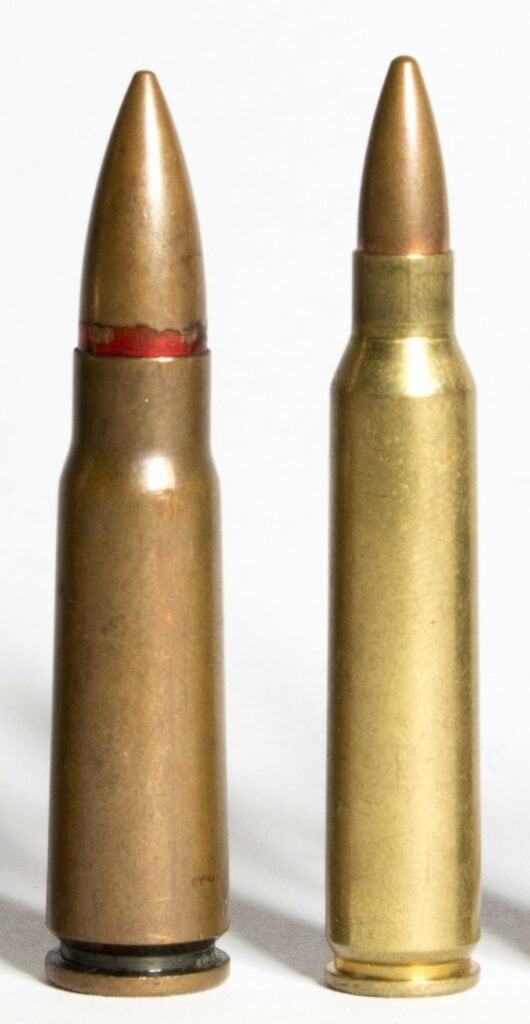
5.56 vs 7.62: Ballistics
The ballistics of a bullet determine its usability for different situations. The factors primarily concerned with this are the bullet drop, velocity, and kinetic energy at different ranges. The values of these factors determine if a bullet is suitable for long range, short range, armor penetration, or any other specific purposes.
The 5.56 NATO is clearly a lightweight supersonic round that features a comparatively flatter trajectory but at the cost of power. Let’s take this and several other factors into consideration
5.56 vs 7.62: Trajectory
The measurement of trajectory for a bullet describes how flat it shoots over a distance. This takes into consideration many factors and specifies if a bullet will be suitable over a long range. The height to which the projectile drops down towards the earth due to the effect of gravity is termed as bullet drop. Those bullets which show lesser drop require lesser scope adjustment when shooting at a long range.
5.56 NATO
 | 9” barrel BC .304 62 gr M855A1 Supersonic | 18” barrel/BC .372/77 gr Supersonic | 20” barrel/BC 0.220/55 gr Supersonic |
|---|---|---|---|
| 100 yds | 0” Drop | 0” Drop | 0” Drop |
| 200 yds | 4.2” Drop | 3.1“ Drop | 4.40” Drop |
| 300 yds | 17.2” Drop | 13.21” Drop | 17.50” Drop |
| 500 yds | 56.9” Drop | 60.34” Drop | 83.3” Drop |
7.62 NATO
| 20” barrel/BC 0.409/150 gr FMJ Boat-tail | 20” barrel/BC 0.503/175 gr BTHP | 20” barrel/BC 0.475/165 gr Nosler Accubond |
| 100 yds: 0” Drop | 100 yds: 0” Drop | 100 yds: 0” Drop |
| 200 yds: 3.6” Drop | 200 yds: 4.4” Drop | 200 yds: 4.01” Drop |
| 300 yds: 13.4” Drop | 300 yds: 15.65” Drop | 300 yds: 14.43” Drop |
| 500 yds: 56.4” Drop | 500 yds: 63.1” Drop | 500 yds: 58.92” Drop |
A close comparison of the trajectory of 5.56 and 7.62 NATO bullets shows some amazing facts. It seems that the 7.62 NATO despite being a heavy bullet shows good drop-resistance at long range. In fact, the drop characteristics for both these bullets within a range of 500 yards are almost the same.
So does the 7.62 NATO excel over the 5.56 NATO? If you are punching paper targets at 500 yards or less, either of these bullets will do the job. Since the drop characteristics are similar for both these bullets within that range.
The areas where the 5.56 NATO will prove to be a better fit will be recoil, rifle weight, and overall ammo weight. A rifle chambered for 5.56 NATO will generally be more lightweight and have a lesser recoil, also reducing the need for compensators when shooting long range.
However, the 7.62 NATO is an amazing pick for long range shooting, especially when distances beyond 900 yards are concerned. While the 5.56 NATO loses elevation quickly past that range, the 7.62 NATO drops only half of that.

5.56 vs 7.62: Velocity & Kinetic Energy
The velocity and energy carried by a bullet at different ranges are important in determining the maximum effective range and expected damage on targets. Fast moving bullets tend to be less affected by wind drift along with delivering a shorter travel time for distant targets. Let’s make a quick comparison of velocity and energy among the most common 5.56 NATO and 7.62 NATO loads.
5.56 Velocity & Momentum in Typical Use Cases
| 9” barrel/BC .304/62 gr M855A1 | 18” barrel/BC .372/77 gr Supersonic | 20” barrel/BC 0.220/55 gr Supersonic |
| 100 yds: 2,308 ft/s, 733 ft.lbs | 100 yds: 2,482 ft/s, 1,053 ft.lbs | 100 yds: 2,837 ft/s, 983 ft.lbs |
| 200 yds: 2,045 ft/s, 576 ft.lbs | 200 yds: 2,256 ft/s, 870 ft.lbs | 200 yds: 2,468 ft/s, 744 ft.lbs |
| 300 yds: 1,802 ft/s, 447 ft.lbs | 300 yds: 2,042 ft/s, 713 ft.lbs | 300 yds: 2,128 ft/s, 553 ft.lbs |
| 500 yds: 1,384 ft/s, 264 ft.lbs | 500 yds: 1,653 ft/s, 467 ft.lbs | 500 yds: 1,540 ft/s, 290 ft.lbs |
7.62 Velocity & Momentum in Typical Use Cases
| 20” barrel/BC 0.409/150 gr FMJ Boat-tail | 20” barrel/BC 0.503/175 gr BTHP | 20” barrel/BC 0.475/165 gr Nosler Accubond |
| 100 yds: 2.598 ft/s, 2,248 ft.lbs | 100 yds: 2.427 ft/s, 2,288 ft.lbs | 100 yds: 2.513 ft/s, 2,313 ft.lbs |
| 200 yds: 2,387 ft/s, 1,897 ft.lbs | 200 yds: 2,261 ft/s, 1,986 ft.lbs | 200 yds: 2,334 ft/s, 1,996 ft.lbs |
| 300 yds: 2,185 ft/s, 1,590 ft.lbs | 300 yds: 2,101 ft/s, 1,715 ft.lbs | 300 yds: 2,162 ft/s, 1,712 ft.lbs |
| 500 yds: 1,812 ft/s, 1,093 ft.lbs | 500 yds: 1,802 ft/s, 1,262 ft.lbs | 500 yds: 1,841 ft/s, 1,242 ft.lbs |
If you look closely at the data table comparing the velocity and energy of 5.56 and 7.62 NATO rounds. You will notice that almost all comparable bullet weights from either of these cartridges exist at a similar muzzle velocity.
With the 5.56 NATO, the supersonic muzzle velocity is a result of the lightweight projectile. Whereas the supersonic speeds are necessary for heavier 7.62 NATO bullets to get the expected output.
Both these bullets stay supersonic past 1,000 yards, which is great because it helps with the momentum (more on than in the next section). However, the 5.56 NATO falls way short of the 7.62 NATO in terms of energy as the range increases.
The 7.62 NATO is used by many militaries for long range target engagement with light machine guns and sniper rifles for a good reason. The round does not lose too much energy with increasing distance and retains about 1,000 foot-pounds of energy at 600 yards. Whereas the 5.56 NATO does not even reach 1,000 foot-pounds with common bullet loads.
This is the reason why 7.62 NATO is a popular machine gun, sniping, and hunting cartridge. Whereas the 5.56 NATO is mostly used for close-quarter engagements and never for hunting medium or big-sized game.

5.56 vs 7.62: Stopping Power
Stopping power refers to the capability of a moving bullet to incapacitate a living target (human or animal). In some cases, this will also be used to measure the lethality of a bullet at different ranges and targets. Let’s understand the difference between the stopping power of these two rounds and the precautions and considerations you must keep in mind before using them.
5.56 vs 7.62: Momentum & Sectional Density
Getting a bit technical, the two most reliable metrics to understand the stopping power of a moving bullet are its sectional density and momentum. If I describe it in layman terms, the sectional density describes the penetrating potential of a bullet, whereas the momentum describes the resistance towards slowing down and the potential of energy transfer. Let’s compare these first and then we will try to deduce the facts.
5.56
| 9” barrel/BC .304/62 gr M855A1 Sectional Density: 0.177 | 18” barrel/BC .372/77 gr Supersonic Sectional Density: 0.219 | 20” barrel/BC 0.220/55 gr Supersonic Sectional Density: 0.157 |
| 100 yds: 20.44 lb.ft/s | 100 yds: 27.30 lb.ft/s | 100 yds: 22.29 lb.ft/s |
| 200 yds: 18.11 lb.ft/s | 200 yds: 24.81 lb.ft/s | 200 yds: 19.39 lb.ft/s |
| 300 yds: 15.96 lb.ft/s | 300 yds: 22.46 lb.ft/s | 300 yds: 16.72 lb.ft/s |
| 500 yds: 12.25 lb.ft/s | 500 yds: 18.18 lb.ft/s | 500 yds: 12.10 lb.ft/s |
7.62
| 20” barrel/BC 0.409/150 gr FMJ Boat-tail Sectional Density: 0.226 | 20” barrel/BC 0.503/175 gr BTHP Sectional Density: 0.264 | 20” barrel/BC 0.475/165 gr Nosler Accubond Sectional Density: 0.248 |
| 100 yds: 55.67 lb.ft/s | 100 yds: 60.67 lb.ft/s | 100 yds: 59.23 lb.ft/s |
| 200 yds: 51.15 lb.ft/s | 200 yds: 56.52 lb.ft/s | 200 yds: 55.01 lb.ft/s |
| 300 yds: 46.82 lb.ft/s | 300 yds: 52.52 lb.ft/s | 300 yds: 50.96 lb.ft/s |
| 500 yds: 38.82 lb.ft/s | 500 yds: 41.32 lb.ft/s | 500 yds: 43.39 lb.ft/s |
The momentum of any moving object is calculated as mass times its velocity. Which means that a lighter bullet with a fast velocity can have equal momentum when compared to a heavier bullet with a slower velocity.
According to velocity comparison tables, the differentiating factor between 5.56 and 7.62 NATO is the mass and sectional density of the bullets. Since the velocity of these bullets is pretty much similar at distances out to 800 yards.
The higher sectional density of 7.62 NATO bullets means better penetration. Which is a reason why these rounds are popular for hunting big game and also for penetrating barriers or armor (although that depends upon the type of bullet).
The 7.62 NATO is a clear winner in terms of penetration compared to the 5.56 NATO. However, the latter is a better cartridge as far as incapacitating a target is concerned. The 5.56 NATO is mostly carried by infantry because it is very easy to handle (low recoil and weight), and carries enough energy to maim a hostile. As a matter of fact, humans are quite fragile beings and take very little energy to incapacitate.
On the other hand, this extra penetration power of the 7.62 NATO round makes it an overkill for some small game and also an unfavorable choice for close-quarter uses (like home defense).
5.56 vs 7.62: Use Cases & Effective Range
The 7.62 NATO aka the .308 Winchester has been a proven and reliable cartridge for decades. The 5.56 NATO was developed to minimize its power and to solve the modern close quarter battle issues. However, the 7.62 NATO hasn’t lost its shine yet and is still widely popular.
Each of these cartridges has their own pros and cons. Let’s divide them into different common use cases and understand their usability.
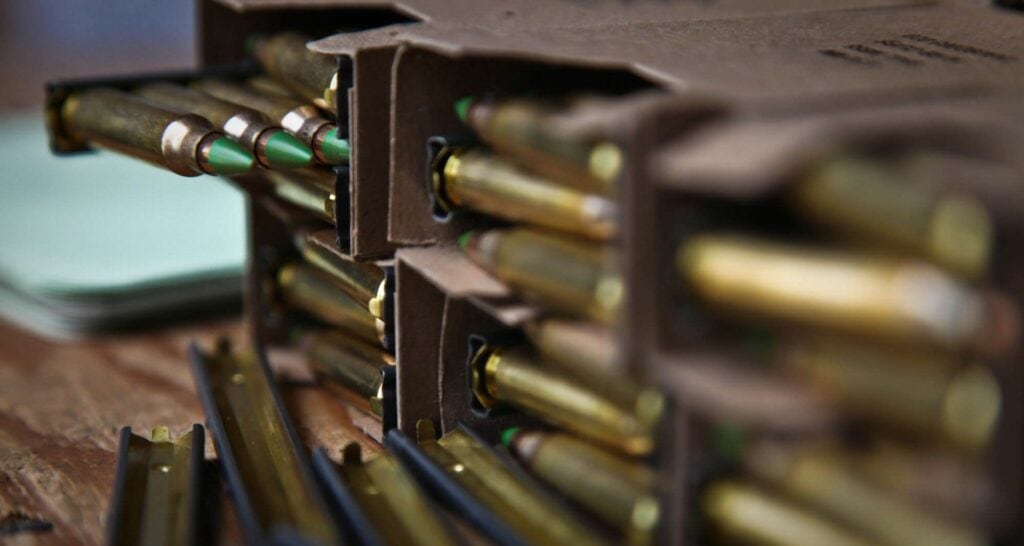
Versatile Hunting Rounds
The 5.56 NATO round propels a .224 inches diameter bullet towards the target. Bullets of .22 caliber range are considered fit only for varminting and small game hunting. In fact, the .223 bullets are also banned in most states for hunting deer. That is because of the low-hitting power and state laws generally consider 1,000 fpe as a minimum for hunting deer. As far as game up to the size of coyotes are concerned, the 5.56 NATO is a great choice.
The 7.62 NATO can be considered a very versatile hunting round. The .308 caliber bullet is a favorite for many hunters because of its high stopping power and long effective range. The round carries out 1,500 fpe at 300 yards which is considered enough to humanely harvest an elk or moose. These rounds can also be used to hunt black bears are another CXP4 category dangerous big game animals.
Long Range Shooting
The clear cut winner for long range shooting uses is the 7.62 NATO. With an effective range of more than 800 yards and the capability of being shot out to more than 1,500 yards with the right rifle and shooter.
The 7.62 NATO is definitely not the flattest shooting cartridge out there, but if you are planning to send a significant amount of energy downrage at or beyond 500 yards, it will not disappoint you.
On the other hand, the 5.56 NATO is more of a medium range cartridge. It can be used effectively out to 700 or 800 yards if you are hitting paper targets. But frankly speaking, there are many better options for long range shooting when compared to these two.
Range Practice
Choosing either of these rounds for use at the range will depend upon your needs. However, as far as economics is concerned, shooting 7.62 rounds is almost twice as expensive as 5.56. Additionally, if you burn a lot of ammo at the range and do not want a sore shoulder at the end, the 5.56 will be a better choice.

5.56 vs 7.62: Costs, Availability, & Compatibility
Buying ammo or choosing a rifle of a specific caliber has some important aspects to it. Apart from its performance, factors such as availability, versatility, and ammo costs have to be taken into consideration.
Military Ammo Is Cheap and Abundant. Really?
Apart from washing hands, social distancing, and wearing masks, one thing the Covid-19 pandemic taught us was that toilet paper and ammo will disappear from market shelves in no time.
5.56 NATO ammunition is fairly cheap, even to the point that you can find ammo for as low as 25 cents per round. Since it is the official cartridge for NATO countries, there is also a good possibility for finding milsurp rounds for cheap.
Talking about the 7.62 NATO, the ammo will cost about twice or thrice more (even more for match grade ammo) than 5.56 NATO. Which is quite self-explanatory when you look at the size and ballistics of the bullet.
The insane popularity of these rounds means that when there’s an SHTF situation like the Covid-19, commonly used rounds will disappear first from the market. However, since these rounds are also used by the military, there will never be a severe shortage.

Semi-auto vs Bolt Action Use
In civilian hands, the 7.62 NATO is more preferable in bolt action rifles. That is due to its long design and heavy recoil that can make the gun less controllable with a faster rate of fire. Additionally, semi-auto rifles chambered for the 7.62 NATO will be heavy.
As far as the 5.56 NATO is concerned, it is the dream caliber for semi-auto rifles. The recoil is super-manageable even by a rookie and the bullets retain enough energy to handle anything at close range. Additionally, being popular calibers, there’s a wide range of rifle options available from major manufacturers.
Bottom Line
The 5.56 NATO was designed as a lightweight and low-recoil version for the 7.62 NATO which is considered overpowered for modern close-quarter battlefields. While the 5.56 NATO was designed for short range, it carries less foot-pounds of energy and has an effective lethal range of only 300 yards. The 7.62 NATO was made for long range and shoots at velocities similar to the 5.56 NATO, but with decimating power even at 1,000 yards.


